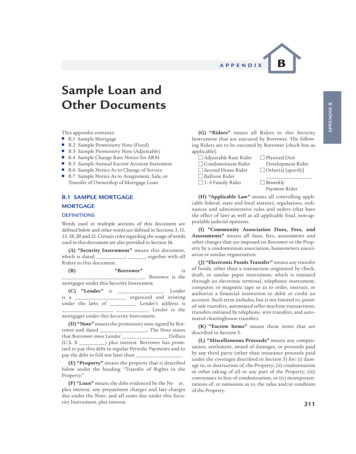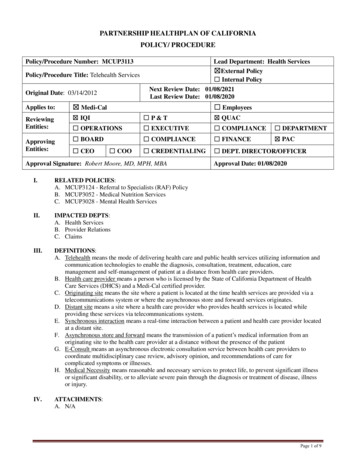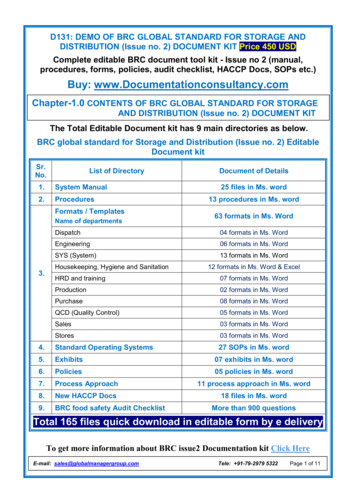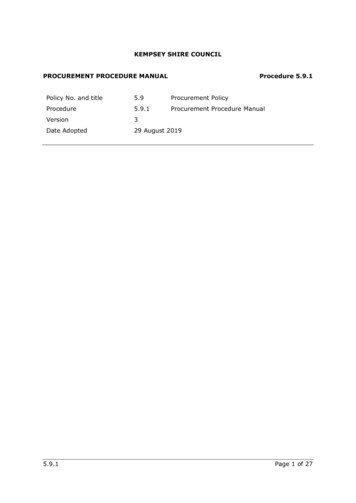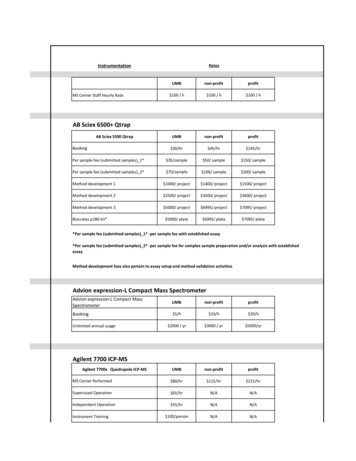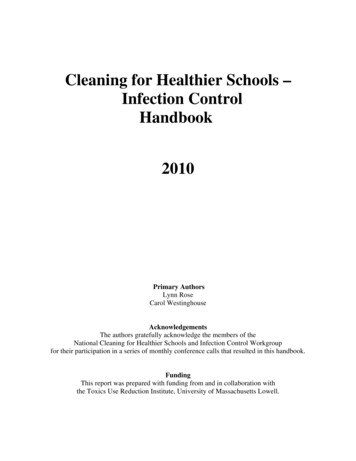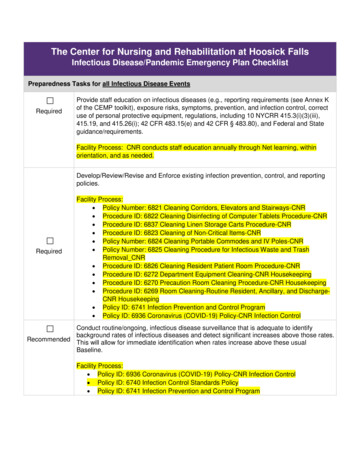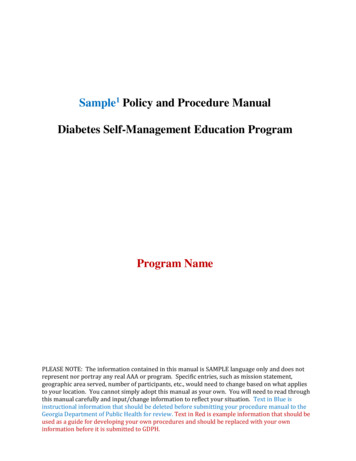
Transcription
Sample1 Policy and Procedure ManualDiabetes Self-Management Education ProgramProgram NamePLEASE NOTE: The information contained in this manual is SAMPLE language only and does notrepresent nor portray any real AAA or program. Specific entries, such as mission statement,geographic area served, number of participants, etc., would need to change based on what appliesto your location. You cannot simply adopt this manual as your own. You will need to read throughthis manual carefully and input/change information to reflect your situation. Text in Blue isinstructional information that should be deleted before submitting your procedure manual to theGeorgia Department of Public Health for review. Text in Red is example information that should beused as a guide for developing your own procedures and should be replaced with your owninformation before it is submitted to GDPH.
Table of ContentsIntroduction3Policies and Procedures Specific to the Ten National StandardsStandard 1 – Internal Structure4Standard 2 – Stakeholder Input7Standard 3 – Evaluation of Population8Standard 4 – Quality Coordinator Overseeing DSME Services9Standard 5 – DSME Team11Standard 6 – Curriculum16Standard 7 – Individualization20Standard 8 – Ongoing Support28Standard 9 – Patient Progress32Standard 10 – Quality Improvement35Page 2 of 38
IntroductionThe Insert Program Name is based on the ten (10) National Standards for Diabetes SelfManagement Education and Support. The Insert Program Name Quality Coordinator andrelevant stakeholders review the policies and procedures for the Insert Program Name at leastannually.The National Standards are reviewed every 5 years, when changes are made, the policies andprocedures will be amended to reflect those changes.Initial Implementation Date for the Insert Program Name Policy and Procedure Manual:Date of Initial ApprovalQuality Coordinator Signature9/1/2017Policy Update Log (example entries):Date ApprovedSeptember 5, 2012Section/ParagraphAmendedSection 3, Paragraph 1ETC.ETC.ChangeRevised section relating toCHW supervisionETC.Page 3 of 38
The Ten 2017 DSMES National Standards (July 2017 standards, currentversion) and Policy Manual[Here each of the standards are repeated, with the policies and procedures applicable to eachstandard. The procedures should be replaced with your location specific guidelines. Refer to theAADE Initial Application Document Check List to ensure you have included all theinformation needed for application approval.]Standard 1 - Internal StructureThe provider(s) of DSMES services will define and document a mission statement and goals.The DSMES services are incorporated within the organization- large, small, or independentlyoperated.Policies and Procedures Applicable to Standard 1:Mission Statement:The Insert Program Name is committed to improving the quality of life and maintaining thedignity of older adults in our region. We achieve this mission by providing leadership andsupport, developing community partnerships, establishing comprehensive services, anddisseminating accurate information.Program Goals: To develop programs that meet the changing needs of the area’s aging population To collaborate with other organizations to develop a comprehensive network of servicesfor older adults in our community To secure adequate funding to serve the growing and diverse aging population To promote the well-being of older adults and empowering them through high-qualityinformation and programsDiabetes education is part of Insert Program Name mission:As part of Insert Program Name core services and mission, we provide services funded in partthrough the Older Americans Act. These services include health promotion and diseaseprevention (Title IIID of the Older Americans Act). As a result of this focus on health, weexpanded our core services to provide the Chronic Disease Self-Management Program(CDSMP) and the Diabetes Self-Management Program (DSMP). Insert Program Name targetsolder adults most in need; our Diabetes Self-Management classes focus on reaching older adultsin minority groups who are most affected by diabetes and diabetes-related complications in ourservice area.Page 4 of 38
Page 5 of 38
Below are the guidelines for the Stanford Program. You may leave the information in if youwill be using the Stanford class design (1 intro week with individual assessment, 6 weeks ofgroup classes, 1 closing week with a post-assessment and future planning). If you are using adifferent class design, please describe your basic class structure here (plan for staffing,number of classes and how far apart, how long will each class be, etc.), and ensure it meetsAADE guidelines. Do not go into detail pertaining to the curriculum here, the curriculuminformation is included under Standard 6.Diabetes Self-Management Education Program Mission Statement:Our mission is to empower our clients with the diabetes self-care management skillsnecessary to improve their quality of life, using what they have learned through diabeteseducation and disease management strategies.Diabetes Education Process and Self-Management Support:The Insert Program Name is an eight-week intervention, which begins with each participantundergoing a detailed individual assessment conducted by the program’s primary qualifiedinstructor (PQI), a registered dietician. Based on the results of the individual assessment, thePQI develops a comprehensive education plan. A key component of the individual assessmentand education plan is the establishment of individualized goals and self-management supportstrategies. This initial session is week 1 of the eight-week intervention.After completion of week 1, the participant participates in the six (6) week Stanford DiabetesSelf-Management Training program. Two trained Community Health Workers, under thesupervision of the PQI, facilitate the group workshops from a highly-detailed manual.Participants, in the group education sessions make weekly action plans, share experiences, andhelp each other solve problems they encounter in creating and carrying out their individualizedself-management program.The PQI directs the material covered during the group sessions. In addition, the groupinstruction occurs in a setting that allows for interaction between the participants and the trainedgroup leaders. The PQI maintains responsibility for providing direct supervision of theeducational process in the least obtrusive manner possible.Physicians and other health professionals both at Self-Management Research Center and in theacademic and healthcare community have reviewed all materials in the course. The instructionalmaterials have been provided to our program’s Advisory Council as part of our continual qualityimprovement review process. Workshops are conducted in a manner to encourage fullparticipation by all members of the group. The group learning process increases participants’ability to learn self-management behaviors in an environment of mutual support enabling themto build on the success of their peers.Page 6 of 38
At the completion of the six-week group training sessions, each participant will complete afollow up assessment with the PQI to review their effectiveness in achieving the goals of theirindividualized education plan. This review provides the PQI with an opportunity to augment andmodify the participant’s disease self-management plan, if necessary. All follow up iscommunicated by PQI to both the participant and the referring primary care manager.This review constitutes the 8th week in the eight-week intervention.Link to Self-Management Research ams/small-group/diabetes-self-managementLink to more information about the Stanford t/Page 7 of 38
-------Standard 2 - Stakeholder InputThe provider(s) of DSMES services will seek ongoing input from valued stakeholders andexperts to promote quality and enhance participant utilization.Policies and Procedures Applicable to Standard 2:The Insert Program Name program will seek stakeholder input to promote quality and enhanceparticipant utilization in the program. Stakeholders will be from various interest groups (DSMEparticipants, practitioners, community groups, outside health professionals, etc.) to ensure needsof the community are being met.Planned strategy for engaging stakeholders:1.) Identify social determinants related to our population and anticipated challenges inimplementing the DSME program.2.) Identify interest groups that may be able to help foster ideas related to improving theprogram and addressing the social determinants of program utilization.3.) Reach out to the interest groups/stakeholders identified. Document our efforts, discussionkey-points and any actions plans that are created.4.) Create plan to reevaluate stakeholders and obtain continued input.Below is an example of the document that will be used to plan stakeholder involvement anddocument discussions.StakeholderDiscussion SummaryList Stakeholders HereList contact attempts, methods of contact,discussion key points, next steps, etc.Be sure to include:-Name-Position-Credentials-Planned Contribution (why are wecontacting them and what insight do we thinkthey can help us provide)ETC.ETC.ETC.ETC.Annual tasks to be performed by the Quality Coordinator in collaboration with relevantstakeholder input: Actively reviews the DSMES programActively reviews the CQI data reportsMakes recommendations to help improve and maintain the programReviews the annual program plan and evaluationReviews the Continuous Quality Improvement PlanAnnually reviews the current policy and procedure manualAnnually summarizes stakeholder input and communications in a report for AADEPage 8 of 38
-------Standard 3 – Evaluation of Population ServedThe provider(s) of DSMES services will evaluate the communities they serve to determine theresources, design, and delivery methods that will align with the population’s need for DSMESservices.Policies and Procedures Applicable to Standard 3:Below are links to websites where you can find population health data for your state, county orcity. You can use this information along with your internal patient data to determine your htmlhttp://www.countyhealthrankings.org/Target PopulationGeographic Region: South East Metro, Anywhere USAExpected Volume: 21-100 monthlySettings: Older Adult Activity Centers in South East Metro areaSetting Descriptors: Wheelchair and Mobility accessible, handicap parking available at alllocations, transportation provided to centers if neededTarget Population's unique characteristic: (consider characteristics such as literacy,transportation, uninsured rate, primary language, etc.) Older Adults (generally age 60 )Tailoring to target population: You should now describe how you plan to tailor your programto the specific needs on the population you identified at need in your above assessment. Thiscan include information on the space you will be using for classes, staffing, materials, times ofclasses, outside support, etc.To meet the needs of this older adult population, the DSMES program will be particularlytailored to address challenges which include, but are not limited to: low vision, hearing loss,limited mobility. Educational material using large print will be utilized when necessary.Hearing assistance devices will be available. All site locations will accommodate walkers,wheelchairs and other devices designed to improve mobility.Program instructors will have experience in working with older adults to have a heightenedability to recognize other needs of the population. While most the target population is Englishspeaking, educational material will be available in the other languages prevalent in thegeographic areas served (Spanish, Cambodian) and translation services will be made availablePage 9 of 38
when necessary. Further, some segments of the target population have incomes at or below thefederal poverty limits.To address the challenge of meeting the needs of low-income elderly consumers, the programincludes information on finding low-cost medication and services. Efforts to assist withtransportation will be incorporated when possible. Any additional barriers and challengesdiscovered for members within the target population will be communicated to the participant'sprimary care provider. All resources expended in support of this DSME will be allocated to meetthe needs of this target population.At least annually, an assessment of the target population will be performed to address access tohealthcare services, cultural influences, barriers to education, and appropriate allocation ofresources. Resources allocated include funding for program intervention and assessment,physical space, transportation costs, etc.-------Standard 4 - Quality Coordinator Overseeing DSMES ServicesA quality coordinator will be designated to ensure implementation of the Standards and overseethe DSMES services. The quality coordinator is responsible for all components of DSMES,including evidence-based practice, service design, evaluation, and continuous qualityimprovement.Policies and Procedures Applicable to Standard 4:The Insert Program Name will maintain the services of a Quality Coordinator. The QualityCoordinator has the responsibility of providing oversight of the DSMES program, includingplanning, implementation, and evaluation of education services.Program Coordinator Job Description: Insert the Quality Coordinator Job Description Here (Sample Below) TITLE: DSMES Quality CoordinatorREPORTS TO: Program Director (manager, administrator, CEO, etc.)SUPERVISES: DSMES program staff (primary qualified instructors, group leaders)POSITION OVERVIEW: Provides oversight for planning, implementation andevaluation of the DSMES program and ensures the systematic and coordinateddelivery of diabetes educational services.DUTIES AND RESPONSIBILITIES: Provides direction for the selection, and ongoing review, of the curriculum and educationalmaterials to ensure they meet the needs of the population targeted.Page 10 of 38
Directs marketing activities.Develops and directs the implementation of an annual program evaluation plan andperformance improvement activities, including CQI projects.Ensures that DSMES program accreditation requirements are met and maintained.Oversees the diabetes educational process and ensures that services are provided in anindividualized and fiscally feasible manner.Develops and maintains relationships and partnerships with community groups, payersand potential referral sources.Interfaces with the Volunteer Accreditation Advisory Group.Maintains 15 hours of continuing education annually as it relates to their profession.KNOWLEDGE, SKILLS AND ABILITIES: Knowledge about chronic disease management and disease self-management educationalprocesses Supervisory abilities Knowledge about program management Proficiency in various computer applications, including spreadsheets Marketing skillsEXPERIENCE/EDUCATION: Education and/or experience in program management Education in, and/or experience with, chronic diseases and disease self-management Insert Quality Coordinator resume here Insert copy of Quality Coordinator’s license/certification here (if applicable) Insert documentation of Quality Coordinator’s pertinent training here (if applicable) Page 11 of 38
-------Standard 5 - DSMES TeamAt least one of the team members responsible for facilitating DSMES services will be aregistered nurse, registered dietician nutritionist, or pharmacist with training and experiencepertinent to DSMES, or be another health care professional holding certification as a diabeteseducator (CDE) or Board Certification in Advanced Diabetes Management (BC-ADM). Otherhealth care workers or diabetes paraprofessionals may contribute to DSMES services withappropriate training in DSMES and with supervision and support by at least one of the teammembers listed above.Policies and Procedures Applicable to Standard 5:The Insert Program Name will have one or more instructors providing Diabetes SelfManagement and Support (DSMS). At least one of the instructors will serve as the PrimaryQualified Instructor (PQI). The Primary Qualified Instructor will be a licensed professional andhold a current license in one of the following professions – Registered Nurse, RegisteredDietitian Nutritionist, Registered Pharmacist, or another health care professional holding a CDEor BD-ADM .The Insert Program Name uses lay leaders/community health workers in the provision ofdiabetes self-management education. Lay leaders/community health workers aid with diabetesself-management education, under the supervision of the Primary Qualified Instructor or otheraffiliated licensed professional instructor for the program.Referral Mechanism:To ensure participants needs are met if they are outside of PQI/lay leader/community healthworker instructor’s scope of practice and expertise the following policy has been implemented.1. The Primary Qualified Instructor will document initial nutrition counseling sessionusing the intake form as described in Standard 7.2. An appropriate referral will be made by the PQI if it is determined during the firstsession that the needs of the participant are beyond their professional knowledge orability.3. Before the start of the program, the PQI will identify licensed providers in thecommunity that the patients can be referred to as needed based on the participant’sneedsa. Exercise Physiologist-Anywhere Medical Centerb. Counselor-Anywhere Medical Centerc. Wound Care-Anywhere Medical Center Emergency Dept.d. Cardiac Rehabilitation-locatione. Vision/Eye Associates- 123 Eye Associatesf. Podiatry- Better Feet Podiatry4. If emergency assistance is needed, 911 will be called and the referring provider willbe notified.5. With the participant’s permission, the individual’s DSME record will be sent to thePage 12 of 38
referring provider’s office. If the PQI determines the participant may need furthercounseling it will be included with the records that are send to the referring provider.The PQI will also make the referring provider aware of any topics the patient had aninterest in, but the instructor was not able to provide counseling on based on ability orit be outside their scope of work.Job Description: Primary Qualified Instructors (PQI) Insert the PQI and Group Leader Job Descriptions Here (Samples Below) TITLE: Professional Diabetes Program Instructor/Primary Qualified Instructor (PQI)REPORTS TO: DSMES Quality CoordinatorSUPERVISES: Non-professional instructional staff, Group LeadersPOSITION OVERVIEW: Provides individualized diabetes self-management education/ training to individuals andgroups according to the Scope of Practice, Standards of Practice, and Standards ofProfessional performance for Diabetes Educators (AADE, 2017). Provides direct supervision of the participating non-professional instructional staff and groupleaders (i.e., community health workers) that assist in delivering the diabetes selfmanagement education program to class participants. The primary qualified instructor isresponsible for selecting community health workers, monitoring their performance, andassuring that they are properly trained. Direct supervision occurs during program instructionand entails: 1) oversight of the instructional material, 2) fidelity checks to ensure thatapproved material is being delivered as intended, 3) direct observation of community healthworker-led instruction, and 4) constant physical availability to assist and answer questionsthat arise during community health worker led instruction periods.DUTIES AND RESPONSIBILITIES:80% (Instruction of program participants): Performs DSMES program participant assessment data, using the AADE7framework, in a collaborative and ongoing manner. Collaboratively develops educational goals, learning objectives and a plan for educationalcontent and teaching methods with DSMES program participants. Provides educational interventions that utilize primarily interactive, collaborative, skillbased training methods and maximizes the use of interactive training methods. Collaboratively develops an individualized follow-up plan with each program participant. Evaluates effectiveness of educational services provided by measuring attainment of learningobjectives. Conducts a follow-up assessment upon completion of DSMES program services, usingoutcome measures from the AADE7 Continuum of Outcomes Framework. Documents assessment data, educational plan, educational services provided and evaluationresults in each participant's educational records.Page 13 of 38
Utilizes a team approach to provide services and collaborates and communicates with teammembers when needed. Identifies when a program participant's needs are outside the scope of the instructor's practiceand expertise, plus arranges for additional services to meet needs. Communicates relevant participant information to primary care provider 20% of the time Participates in the development of training materials. Contributes to, and participates in, a continuous quality improvement process to measureDSMES program and to identify and address opportunities for improvement. Appraises his/her performance to identify areas of strength and areas for improvement andto develop a plan for improvement and growth. Participates in peer review process to evaluate performance of other professionalinstructional staff. Maintains 15 hours of continuing education annually specific to diabetes, diabetes relatedtopics and behavior change and self-management education strategies.KNOWLEDGE, SKILLS AND ABILITIES: In-depth knowledge about current diabetes treatment management. Ability to lead and effectively manage groups. Ability to develop a collaborative, therapeutic alliance with individuals. Basic computer skills (use of Internet and e-mail).EXPERIENCE/EDUCATION: A Registered Nurse, Registered Dietitian, or Registered Pharmacist who is or who iseligible to become a certified diabetes educator. Minimum of 6 months experience (preferably more) providing diabetes education and/or 15contact hours within past year in diabetes and diabetes clinical and educational subjects. Insert Primary Qualified Instructor’s Resume here Insert copy of Primary Qualified Instructor’s license here Insert documentation of Primary Qualified Instructor’s relevant training here Job Description: Group Session Leader Insert Job description(s) of Lay Leaders/Community Health Workers here (Sample Below) TITLE: Group Leader/Community Health WorkerREPORTS TO: DSMES Quality Coordinator and Primary Qualified InstructorSUPERVISES: Non-Supervisory PositionPage 14 of 38
POSITION OVERVIEW: Provides individualized diabetes self-management education/ training to individualsand groups per the Scope of Practice, Standards of Practice, and Standards ofProfessional Performance for Diabetes Educators (AADE, 2017). Community HealthWorkers maintain a non- technical role in providing instruction to programparticipants.DUTIES AND RESPONSIBII.ITIES:80% (Instruction of program participants): Under the supervision of a licensed program instructor or PQI, collects DSMESprogram participant assessment data, using the AADE7 framework, in a collaborativeand ongoing manner.Under the supervision of a licensed program instructor, collaboratively developseducational goals, learning objectives and a plan for educational content andteaching methods with DSMES program participants.Provides non-technical educational interventions that utilize primarily interactive,collaborative, skill based training methods and maximizes the use of interactivetraining methods.Collaboratively with the PQI, develops an individualized follow-up plan witheach program participant.Collaboratively with the PQI, evaluates effectiveness of services provided bymeasuring the attainment of learning objectives.Collaboratively with the PQI, conducts a follow-up assessment upon completion ofDSMES program services, using outcome measures from the AADE7 Continuumof Outcomes Framework.Documents assessment data of the PQI developed educational plan, educationalservices provided, and evaluation results in each participant's educational records.Utilizes a team approach to provide services and collaborates and communicateswith team members when needed.Identifies when a program participant's needs are outside the scope of theinstructor's practice and expertise, plus arranges for additional services tomeet needs.20% of the time: Contributes to the development of training materials. Contributes to, and participates in, a continuous quality improvement process to measureDSMES program and to identify and address opportunities for improvement. Appraises his/her performance to identify areas of strength and areas forimprovement and to develop a plan for improvement and growth. Participates in peer review process to evaluate performance of other non-professionalinstructional staff. Maintains 15 hours of continuing education annually specific to diabetes, diabetesrelated topics and behavior change and self-management education strategies.Page 15 of 38
KNOWLEDGE, SKILLS AND ABILITIES: In-depth knowledge about current diabetes treatment management. Able to lead and effectively manage groups. Ability to develop a collaborative, therapeutic alliance with individuals. Basic computer skills (use of Internet and e-mail). Completion of Stanford CDSMP Training (4 days).EXPERIENCE/EDUCATION: Experience working with community based groups and providing outreach to seniors. Minimum of 6 months experience (preferably more) providing diabetes educationand/or 15 contact hours within past year in diabetes and diabetes clinical andeducational subjects. Experience making oral presentations on health topics in community settings. Insert resume of any instructors that will participate as a group session leader/lay leader Insert any training for group session leaders/lay leaders Insert Documentation for all instructors that shows at least 15 CE credits in the last yearrelated to diabetes, behavior change, chronic disease care or program management Page 16 of 38
-------Standard 6 - CurriculumA curriculum reflecting current evidence and practice guidelines, with criteria for evaluatingoutcomes will serve as the framework for the provision of DSMES. The needs of the individualparticipant will determine which elements of the curriculum are required.Policies and Procedures Applicable to Standard 6: Insert a copy of your program curriculum here. This is a sample. If you are using the Stanfordcurriculum, the below description will likely be similar to your own program. Review thecurriculum below and edit as needed based on how you envision your own program utilizing theStanford curriculum and provide evidence of adaptation to best serve your target population. Ifyou are using a curriculum developed by your clinic/location, ensure the information writtenbelow includes all essential element content areas, adopts the principals of AADE7 behaviors,and maximizes use of interactive training methods. DSMES Curriculum:The Eight (8) week DSMES curriculum set forth below is designed to provide each participantwith an individual assessment and education plan that has been developed collaboratively byparticipant and instructor{s) to direct the selection of appropriate education, interventions andself-management support strategies.Week 1: Individual Assessment with Registered Dietitian or Registered Nurse (PQI):Each new participant will undergo a 1:1 in person assessment with either a Registered Dietitian,or Registered Nurse with training specific to diabetes. The assessment will include informationabout the individual's relevant medical history, age, cultural influences, health beliefs andattitudes, diabetes knowledge, self- management skills and behaviors, readiness to learn, healthliteracy level, physical limitations, family support, and financial status.The current assessment/intake tool is attached and subject to modification as part of our ongoingquality improvement efforts.During this assessment, educational goal(s) and learning objectives, and the plan for educationalcontent and method/s will be developed collaboratively between the participant andinstructor(s). This plan will include, where appropriate, ongoing assessment with the RegisteredDietitian, or Registered Nurse and/or referral to the Stanford Diabetes Self-ManagementProgram (DSMP).During the initial assessment, any additional participant needs that are identified bythe participant, in collaboration with the PQI, will be addressed outside of the Stanford Classindividually, but will be an integral part of the entire DSMES process. This plan will alsoinclude a personalized follow-up plan for ongoing self-management support, which will bedeveloped collaboratively by the participant and instructor (s). The patient's outcomes and goalsand the plan for ongoing self-management support will be communicated and documented.These outcomes and goals may be distinct and in addition to the goal or "action plan"participants develop in the Stanford DSMP program as discussed below. The follow-up plan forPage 17 of 38
ongoing self-management support will focus on long-term self- management that occurs afterthe Stanford DSMP class ends. PQI reviews his/her contact information (telephone and email)with an invitation for participant to contact PQI with any follow up questions or concerns.In an effort to provide an ongoing evaluation of the consumer’s attainment of educationalgoals, the PQI will continue discussions with the participant during the eight- weekinterve
Page 3 of 38 Introduction The Insert Program Name is based on the ten (10) National Standards for Diabetes Self- Management Education and Support. The Insert Program Name Quality Coordinator and relevant stakeholders review the policies and procedures for the Insert Program Name at least annually. The National Standards are reviewed every 5 years, when changes are made, the policies and

